Government Suppression of Protests in US History, From Occupy Wall Street to George Floyd
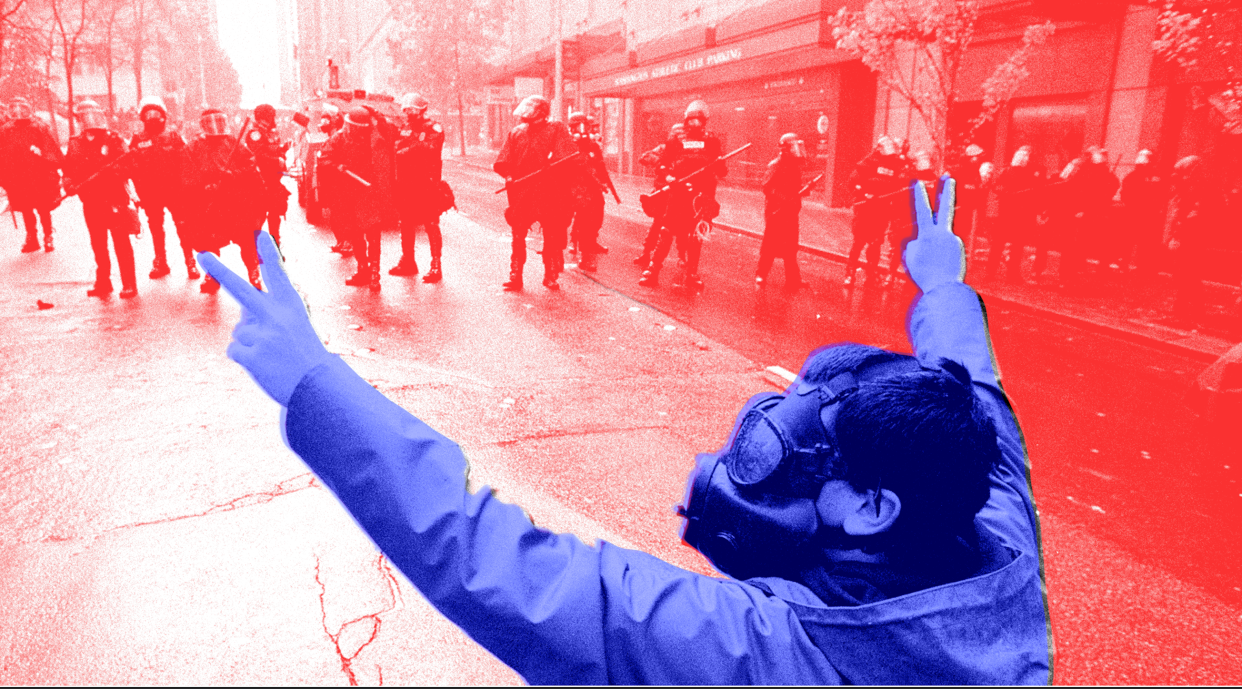
Liz Coulbourn

The right to peaceful assembly is enshrined in our Bill of Rights, one of the earliest documents that defines what it means to be an American. But while protesting in the United States should in theory be a completely secure act, it has often proven not to be.
Just think of historical protests from the 1960s and 1970s that became violent, like the Bloody Sunday civil rights protests in Selma, Alabama, where protesters were beaten by state troopers and local police with billy clubs and whips, or the anti-Vietnam War demonstrations at Kent State University, in which four student protesters were shot and killed by the Ohio National Guard, or the 1969 Stonewall Uprising for LGBTQ+ rights, which led to the arrest of 21 people and left police and protesters injured.
Yet there can be an unintended impact of these tragic actions on protesters, academics say. State repression of demonstrations, including forcibly subduing activists, can build public sympathy for the affected group, said Lisa Mueller, associate professor of political science at Macalester College in Minnesota. Her forthcoming book, The New Science of Social Change: A Modern Handbook for Activists focuses on what makes protests successful — and what makes them fail.
“It’s really important for activists to be aware of who is watching them protest and take control of their own narrative," Mueller told Teen Vogue. “If they are experiencing repression, they should call that out because they can increase sympathy.”
Academic research from Omar Wasow, assistant professor of political science at the University of California, Berkeley, shows that state violence against “peaceful protesters” can lead to media framing that is “effective for activists.” Yet Wasow notes that the media can also perpetuate concerns about “order and sustaining the status quo social hierarchy" when “subordinate group activists fight repression more forcefully.”
Although Wasow focused on the civil rights protests of the 1960s, government suppression of protests, particularly in the United States, is unfortunately not something to be relegated to a history class, neatly shelved as a subject in our past and not our present. Instead, we can find examples from recent history that follow these same patterns. We look back at several below.
Seattle WTO protests in 1999
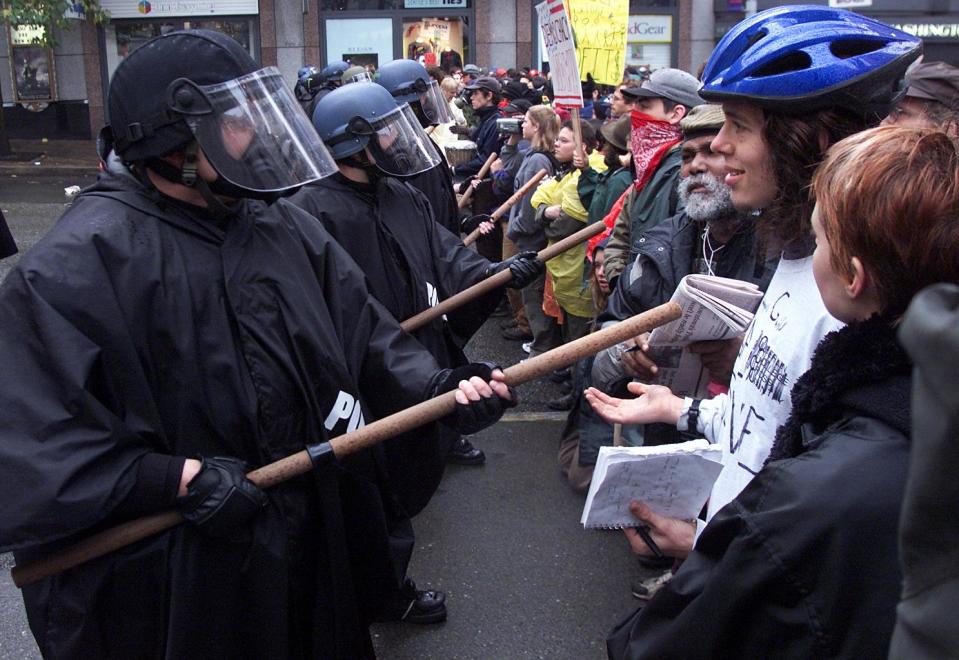
US-WTO-STAND-OFF
DAN LEVINE/Getty ImagesThe city of Seattle likely couldn’t have imagined the chain of events that would be unleashed by its selection as the host of the World Trade Organization Ministerial Conference in 1999. With the aim of negotiating international trade relations, the WTO was an organization not without controversy. But activists took this particular meeting as an opportunity on the world stage to protest “workers’ rights, sustainable economies, and environmental and social issues,” according to Seattle’s municipal archives.
The city was prepared for some degree of protest. In March, the City of Seattle public safety committee started to discuss ways to make sure demonstrators could safely engage in freedom of expression. This era also saw the birth of the internet as an organizing tool that allowed protesters to demonstrate both in-person and online, drawing some 400,000 people to a virtual sit-in on the WTO’s website, while more than 40,000 protesters turned out in Seattle, according to Encyclopedia Britannica.
On November 30, at the opening ceremony of the conference, roughly 10,000 protesters congregated around the Paramount Theatre and the Washington State Convention and Trade Center, where the event would take place. In an attempt to disrupt the opening, protesters crowded the street, some chaining themselves together or locking themselves to metal pipes. The police resorted to tear gas, pepper spray, and rubber bullets to break things up. It didn’t take long for the city to become out of control — some protesters burned trash cans and broke store windows, downtown buses were suspended, and businesses shuttered for the day. President Bill Clinton issued an ultimatum to the city: Control the protesters or the conference would end. The mayor declared a civil emergency, instituting a curfew from 7 p.m. to 7 a.m. in the affected zone.
By the next day, the National Guard and state troopers had descended upon the city. Curfew violations, some vandalism, and ensuing protests led to the arrests of more than 500 people. In response to the arrests and the police decision to battle protesters on the first day, thousands of demonstrators joined a sit-in outside the Seattle police department. Following the protest, Seattle’s police chief resigned and the incident became a prominent example of how to mishandle a political demonstration — and the far-reaching effects of public protest in the digital age.
“Seattle saw the emergence of a new form of, and frame for, protest,” York University sociologist Lesley Wood told Bloomberg in 2019. “It marked a generation of political activism and because it was successful in the actual shutting down of the meeting, which doesn’t happen that often, the story went viral pre-social media.”
2010 Puerto Rico protests
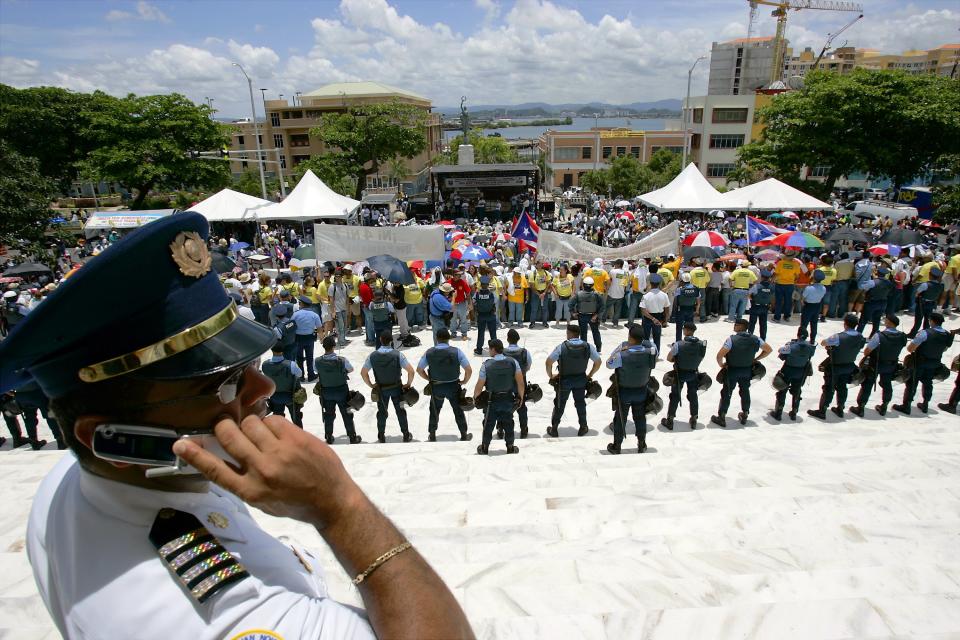
Police stand guard as thousands of protesters gather at a ra
New York Daily News Archive/Getty ImagesBefore the 2010 Puerto Rico protests outside the Capitol building in San Juan, the Puerto Rico police department was already known by the American Civil Liberties Union as a group that regularly used “excessive force against nonviolent protesters,” including pepper spray, tear gas, batons, rubber bullets, and sting ball grenades.
But in 2010, an event would draw this into sharp relief. Puerto Rico considered reducing funds spent on public services by more than $2 billion. On June 30, an activist group that included University of Puerto Rico students and labor union leaders gathered outside the island’s Capitol building in San Juan. The demonstration wasn’t solely against the proposed budgetary decision. They were also protesting the mass layoffs of 30,000 public workers and policy decisions that would hamper the number of students who could afford public university.
But things quickly turned violent when journalists, students, and a legal observer tried to go into the Capitol to observe and report on the final day of Puerto Rico’s already controversial legislative session. According to a 2013 report from a variety of human rights organizations, including the ACLU, the police riot squad “pepper-sprayed them at close range and kicked, pushed, and beat them with batons before throwing them out onto the exterior stairs.” Students trying to enter to deliver a proclamation were beaten with batons and fell down the marble stairs. Per the report, as a crowd amassed at the Capitol, the riot squad formed a perimeter along with other police, didn't instruct the crowd to separate, and “charged, indiscriminately striking, pushing, pepper-spraying, and jabbing students, union members, demonstrating citizens, legal observers, and journalists. Officers fired tear gas canisters from riot guns, in some cases aiming the aluminum projectiles directly at protesters. A low-flying police helicopter sprayed tear gas from above, blanketing the crowd in chemicals."
While the incident attracted attention within the continental United States, the Puerto Rico police department’s superintendent José Figueroa Sancha had no qualms with his staff’s conduct. In fact, per the ACLU, he said he would do the same “today, tomorrow…and next month.”
Occupy Wall Street
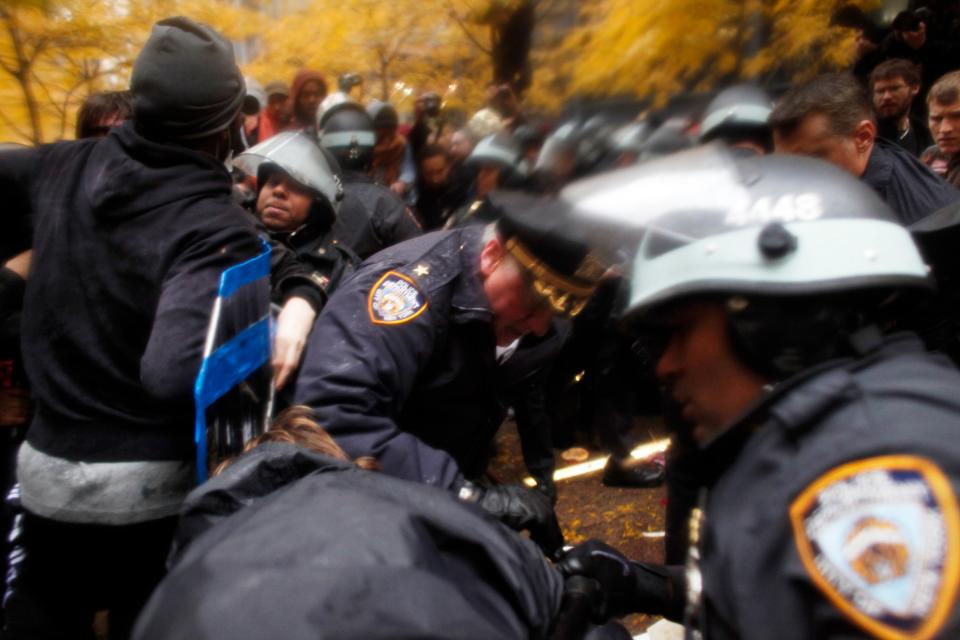
Occupy Wall Street Holds Major Day Of Action In New York City
Allison Joyce/Getty ImagesWhile Mueller calls the Occupy movement the “quintessential low-cohesion movement,” or widespread protest without one cohesive message, it certainly had a visible impact. Occupy Wall Street was dedicated, in large part, to combating socioeconomic inequalities that had built up globally, particularly in the wake of the Great Recession of 2007-2009.
As with many of the protests on this list, the use of public space became a double-edged sword. It both increases visibility and increases the opportunity to face resistance. In the case of Occupy Wall Street, the demonstration lasted for two months, from September 17 to November 15, 2011, in downtown Manhattan. It involved an encampment in Zuccotti Park, where the constant presence of at least 100 to 200 people made it a likely target.
The protest unceremoniously came to an end when the New York City police department took control of the park and arrested roughly 200 protesters for noncompliance. Although mayor Michael Bloomberg had at first indicated that the demonstrators could stay indefinitely, he eventually decided to clear the park because of public health issues.
But a study by the Protest and Assembly Rights Project found that demonstrators suffered aggressive and violent treatment at the hands of police. This included “pervasive surveillance of peaceful political activity,” “obstruction of press freedoms and independent legal monitoring,” violent late-night raids, and “arbitrary and selective rule enforcement and baseless arrests,” among other tactics.
In 2012, while federal prosecutions of economic crimes were at a 20-year low, authorities had arrested more than 7,000 Occupy protesters across the country.
“The government response to Occupy Wall Street in New York City is emblematic of its failure to adequately protect protest rights more broadly,” the report reads. “Reform is needed to ensure that US authorities respect and facilitate — rather than suppress — the ability to peacefully protest.”
Dakota Access pipeline protests
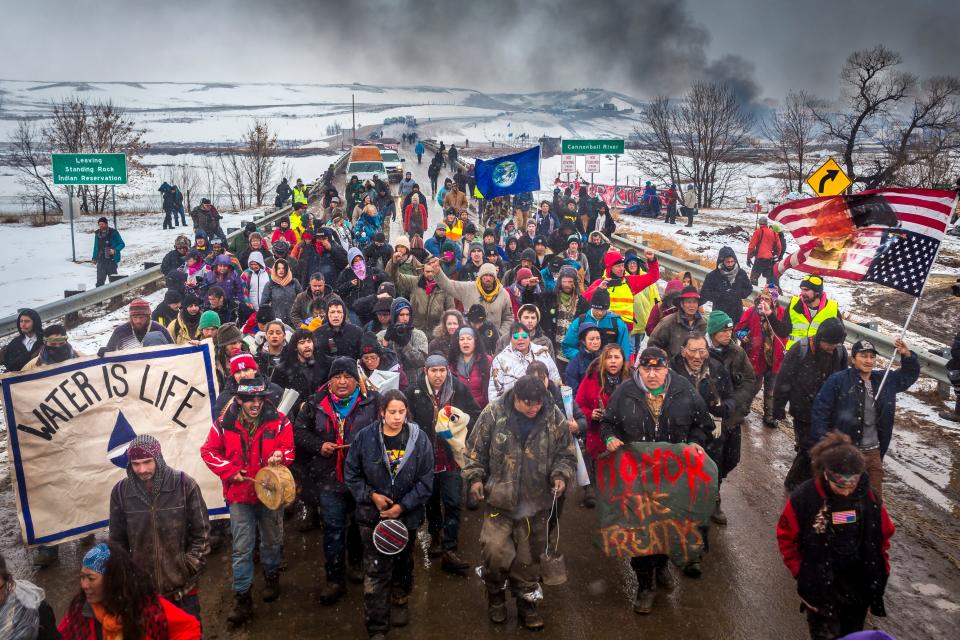
Defiant Dakota Access Pipeline water protectors faced-off
Pacific Press/Getty ImagesDemonstrations against the Dakota Access pipeline began in 2016 when young Native American activists began an ongoing protest of a 1,200-mile-long pipeline from North Dakota to Illinois. Demonstrators opposed the pipeline on the grounds that it was too close to the Standing Rock Sioux Reservation and could lead to a potential oil spill that would contaminate the area’s drinking water.
Instead of one day or a week, protesters put up a camp on the land that would stand from April 2016 to February 2017. Thousands of activists participated in the demonstrations, but by the end of the demonstrations, both North Dakota police and the National Guard were using force to restrain protesters, per The Guardian. This included police in riot gear using pepper spray, tear gas, and other “less than lethal weapons.” Law enforcement had also used “automatic rifles, sound cannons, and concussion grenades against water protectors” in earlier protests, per the ACLU.
“It’s gratuitous. It’s just so excessive,” Irina Lukban, a protester, told The Guardian. She said she was hit in the head with the shield of a National Guard soldier, likely resulting in a concussion. “It’s incredible to see that amount of force.”
In two days of protests around Martin Luther King, Jr. Day in January 2017, police arrested 16 people for trespassing and rioting. They also fired rubber bullets. A Standing Rock tribe member told the newspaper she believed at least 10 people were injured during the protest. But Rob Keller, the spokesperson for the Morton County sheriff, defended the department’s actions. “Less than lethal weapons were used when the protesters were given multiple orders and warnings to move back,” Keller said in a statement published by The Guardian.
The protesters were eventually permanently cleared from the area, putting an end to what was a historic period of activism.
J20 arrests
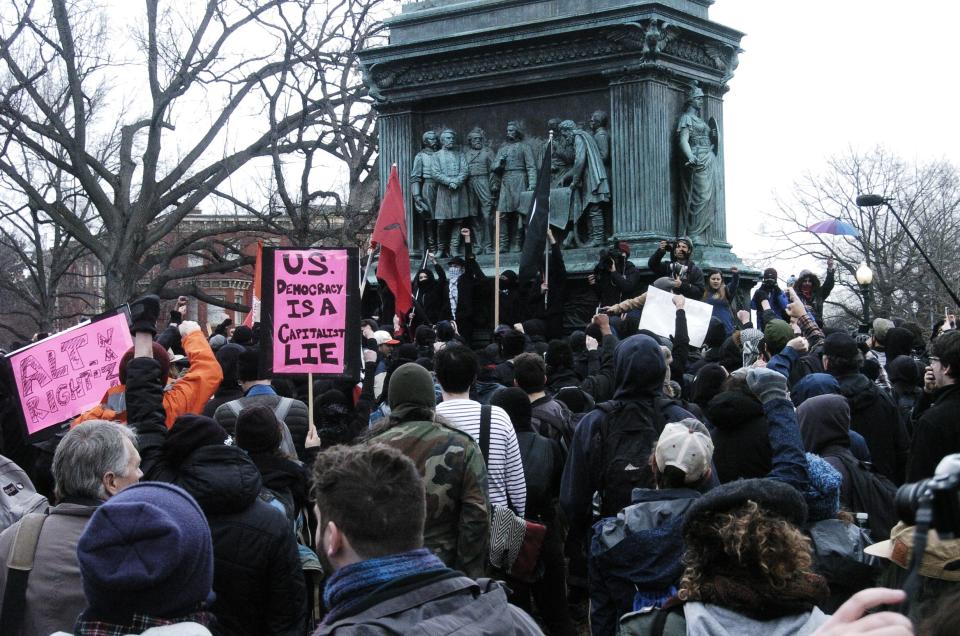
J20 Protests in Washington
NurPhotoDonald Trump’s January 2017 inauguration set off protests across the country, among them the Women’s March in Washington, DC. But the Disrupt J20 protest, billed as an anti-capitalist, anti-fascist “Festival of Resistance,” led to a slate of arrests.
While much of the event unfolded as a typical protest with speeches and gatherings of demonstrators, some attendees tossed rocks and pieces of concrete and broke windows of local businesses. More than 230 people were arrested, including journalists, medics, and bystanders, according to Al Jazeera. They were charged with felony rioting. Among those facing charges were journalist Aaron Cantú, who wrote about his harrowing experience following the protest. The government eventually dropped charges against all the protesters.
In order to arrest so many people, police used a strategy called “kettling,” which forms a barrier around protesters and hems them in to prevent them from leaving without being arrested. Some protesters also allege that they were abused in the process. One said they were “left out on the street for many hours” with “no access to bathrooms, food, water, medical care.” Protesters also alleged that their phones were taken and never given back.
The incident had broader implications in a new world struggling to understand what a Trump presidency would mean. Four years later, a North Carolina protester who attended the demonstration with her 10-year-old son wrote about her experience for the ACLU’s District of Columbia site. Her take: “There is something systematically wrong when police view dissent, including protected speech, as a threat that warrants violent suppression,” said Gwen Frisbie-Fulton.
George Floyd summer

When George Floyd was murdered by Minneapolis police on Memorial Day 2020, gasping, “I can’t breathe,” the world took note. It was the latest in a long line of police killing unarmed Black people in the United States. Earlier that year, Breonna Taylor and Ahmaud Arbery were also killed in Louisville, Kentucky, and Brunswick, Georgia, respectively, Taylor by police and Arbery by two white men in a suburban neighborhood. Enough was enough.
Demonstrations began in Minneapolis but quickly took off across the country, with protesters amassing in more than 140 cities across the United States, according to the New York Times. In cities like Los Angeles and St. Louis, protesters blocked roads and downtowns. Within three days of Floyd’s death, Tim Walz, the governor of Minnesota, had called in the National Guard to control protests in the state.
“Let’s be very clear,” he said at that time. “The situation in Minneapolis is no longer, in any way, about the murder of George Floyd. It is about attacking civil society, instilling fear, and disrupting our great cities.”
However, reports after the fact found definitively that police departments across the country often responded to these demonstrations in an aggressive and violent manner. At least six people were killed related to the protests, according to the New York Times. In Philadelphia, largely peaceful protesters were sprayed with tear gas while caught on an interstate. In Los Angeles, police officers were given foam-projectile launchers to limit crowds, but these ended up having unintended consequences and bloodying the eye of a homeless man in a wheelchair. A Washington Post report showed that at least eight people nationally had severe eye injuries, resulting in partial blindness, from police action at the protests.
Guidance from after-action reports often recommended limited measures such as more training for police departments, clearer guidelines, and “better supervision of crowd control munitions, such as tear gas,” per the New York Times. But the Times’ reporting noted that police behavior in most of the American cities referenced was “strikingly similar,” including officers wearing riot gear, spraying tear gas, and targeting peaceful protesters.
The existing body of research indicates that one thing is clear: “Police wearing so-called riot gear or deploying military-style weapons and tear gas,” per New York Times reporting on three federal commissions conducted between 1967 and 1976, leads to “the same kind of violence it’s supposed to prevent.”
Stay up-to-date with the politics team. Sign up for the Teen Vogue Take
Originally Appeared on Teen Vogue
More great activism coverage from Teen Vogue:


